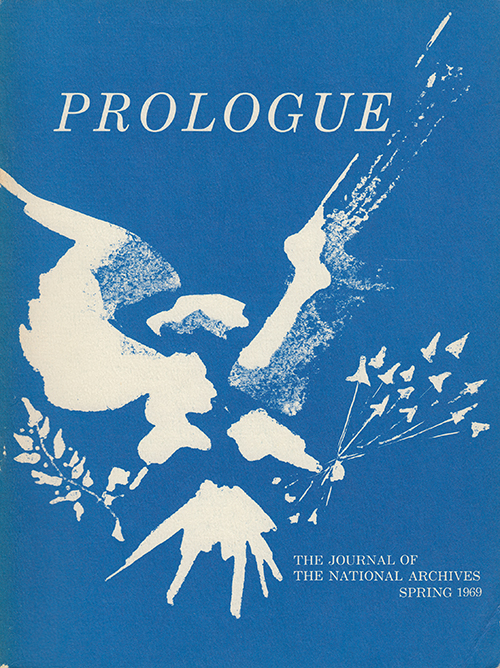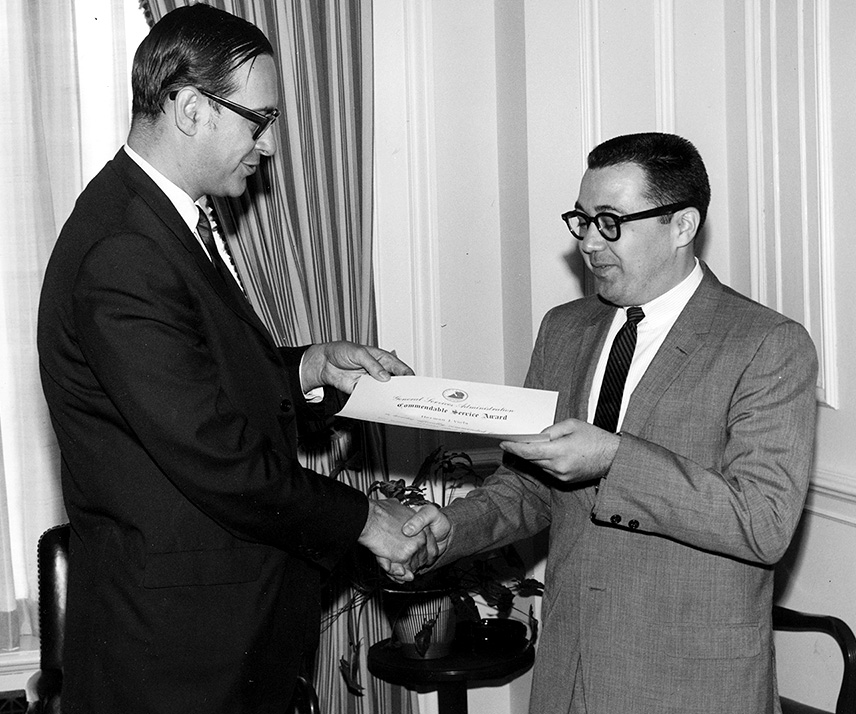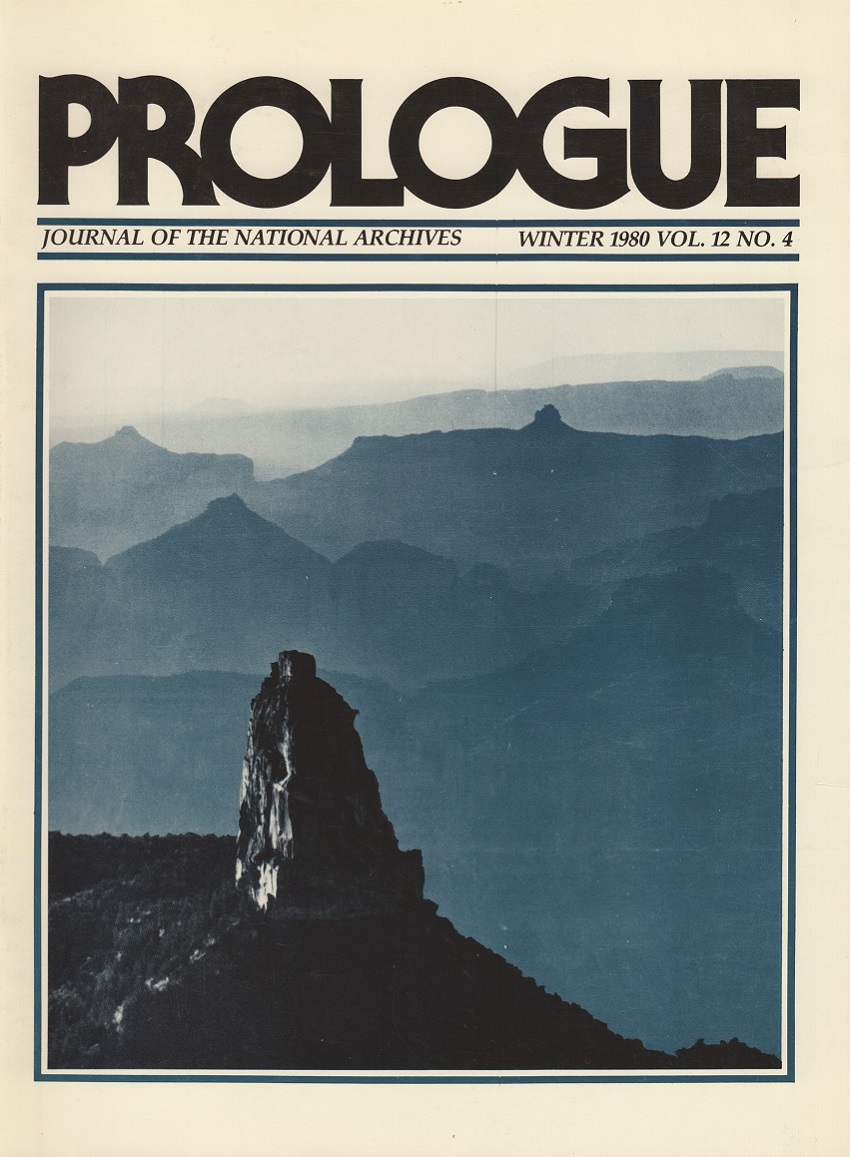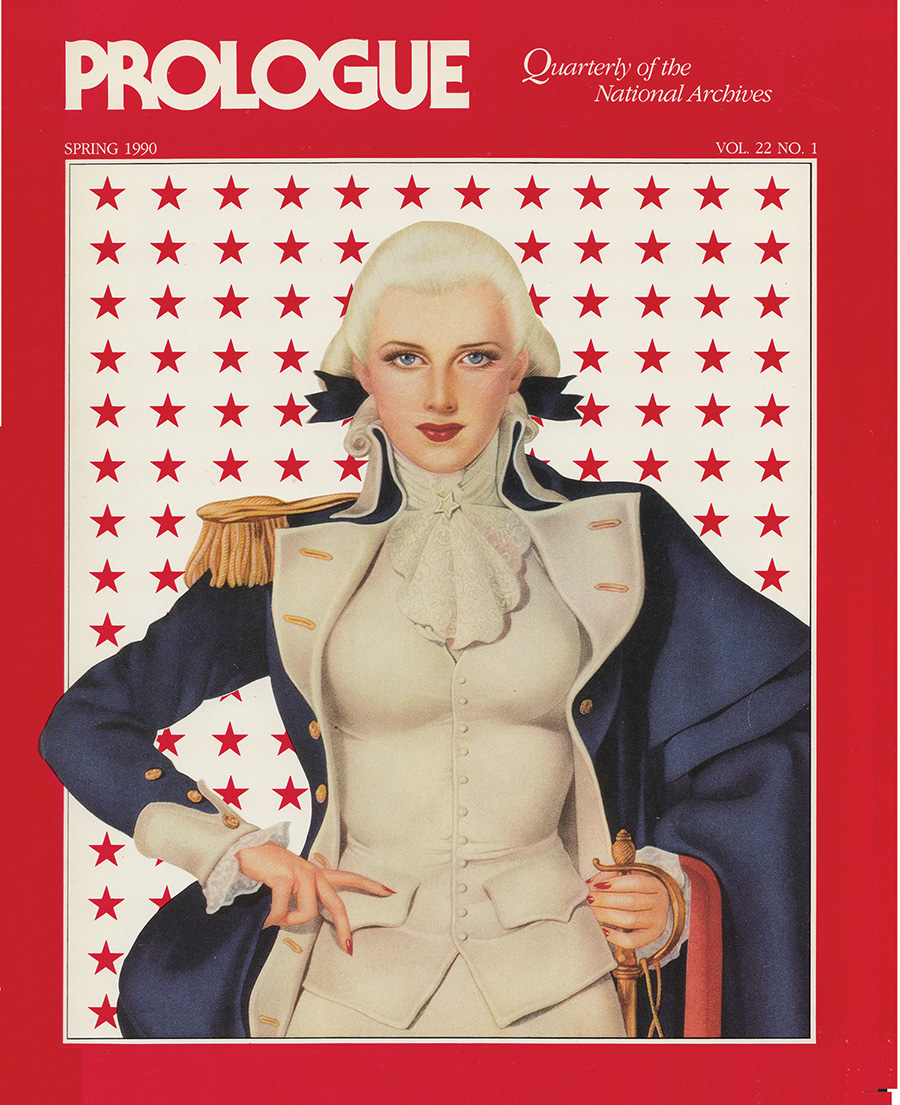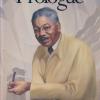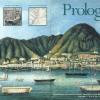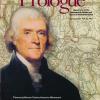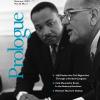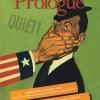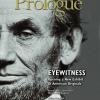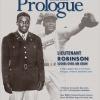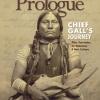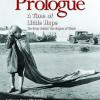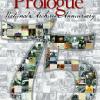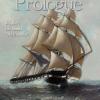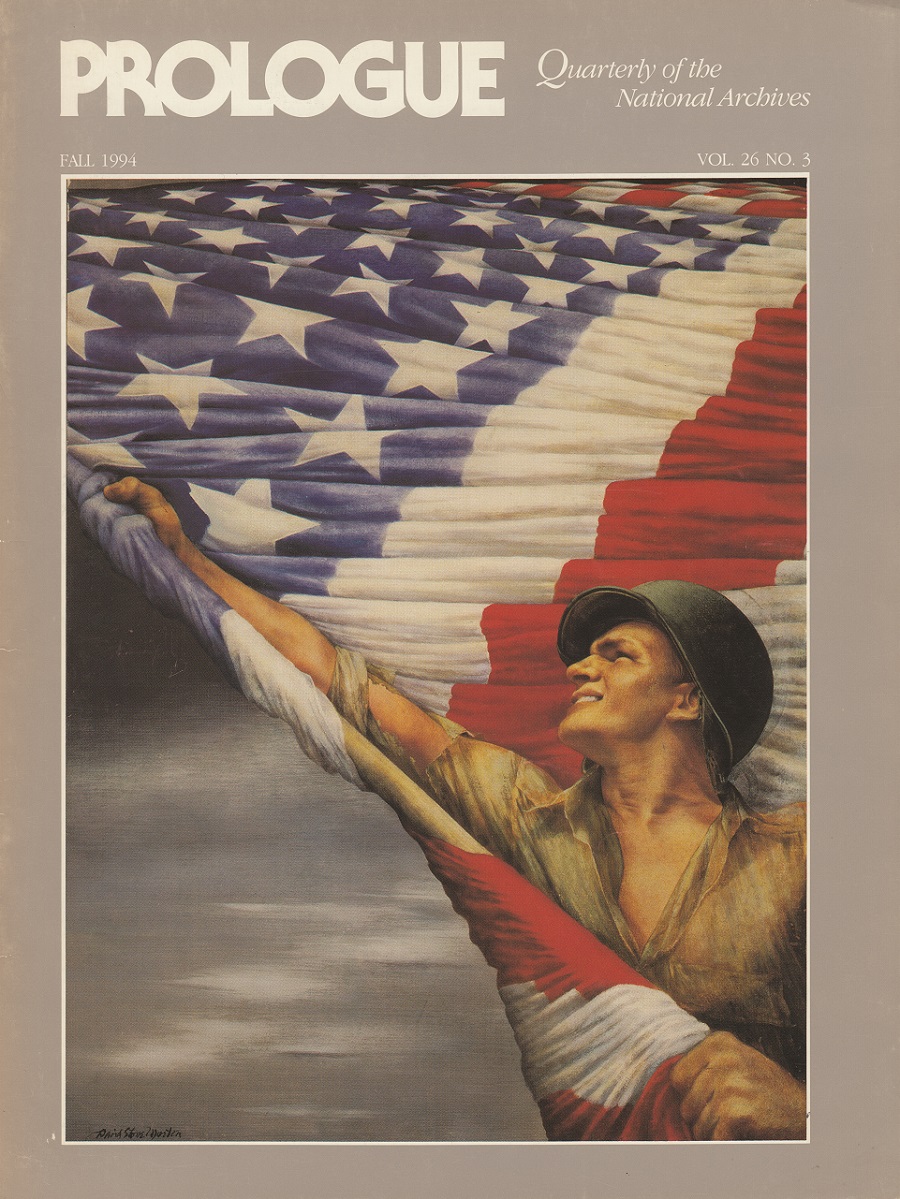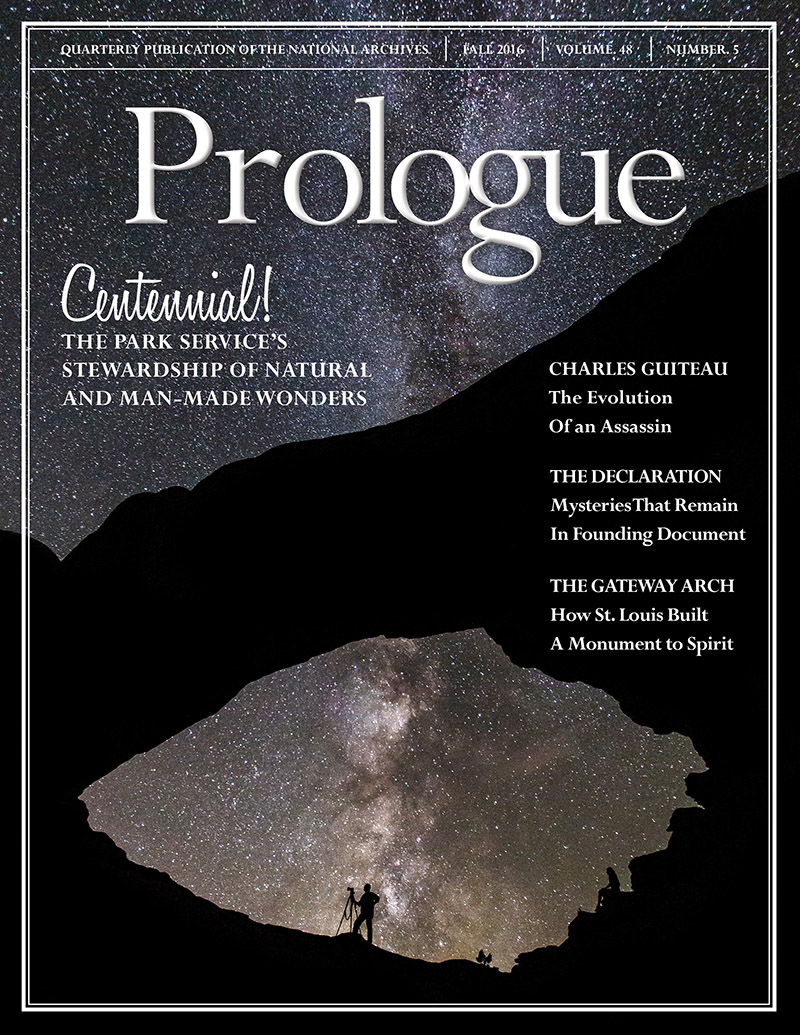
Prologue’s Story—So Far
Magazine Celebrates 49 Years of Discovering History
Winter 2017–18, Vol. 49, no. 4
By David McMillen
In the first issue of Prologue magazine that came off the presses in the spring of 1969, Archivist of the United States James B. Rhoads made clear his concerns for the agency and his hopes for the role Prologue could play in addressing those concerns.
Managing the records of the federal government had become an enormous undertaking since the agency was created in 1934, he wrote in a note titled “What is Past is Prologue,” and the vision its leaders had had of the National Archives as a cultural agency, as well as a records manager, was fading.
Prologue was created to reemphasize the cultural agency role. Articles written by prominent historians and archivists would connect readers with the rich holdings of the National Archives as well as highlight the strength of the professional staff that managed those records.
In his message, Rhoads wrote that he hoped Prologue would bring two classes of scholars—archivists and academicians—closer together and foster more understanding of each other’s worlds and their places in it.
But he also articulated the broader role that he hoped Prologue would play: “The content of the records of the Federal Government entrusted to our care is prologue to the problems and triumphs of this day and the future days of our Nation.”
The first issue of the new publication contained several articles that highlighted some of the National Archives’ cartographic records and an article on the use of federal records in writing history. It also included a feature called “News and Notices,” which continued over the years as a news roundup. There were also standing features listing accessions, publications, and book notes.
Prologue has changed in look and content over the years, but it will have a more meaningful change in the coming year: This issue is the last issue to be printed.
Through focus groups and other means, staff have been exploring new ways to bring you the rich content about our nation’s history that lies in the holdings of the National Archives. On a digital platform, we will be able to share more effectively not only the billions of pages of written records and tens of millions of photographs of our nation’s history but also tens of thousands of miles of audiotapes and video footage.
The result: Prologue will be able to reach many millions more journalists, historians, lawyers, authors, researchers, and ordinary Americans with a thirst for information about their nation’s history.
Prologue’s original purpose was rooted in the forces that pushed for the establishment of a national archives. As early as the 1800s, historians and archivists had urged the creation of an archives as the repository of the important records of the nation. But it did not come until 1934, when President Franklin D. Roosevelt signed legislation creating the National Archives of the United States.
Herman Viola was selected as the first editor of Prologue. Viola, a historian of the American West, brought an academician’s temperament to the task. Prologue was to be a scholarly journal by scholars and for scholars.
Viola served as the editor of Prologue from 1969 to 1972 and was succeeded by John Rumbarger, who took to heart the mission of Prologue as a scholarly journal. He recruited agency historians and academics to write for the journal. During Rumbarger’s tenure, from 1973 to 1982, the journal included articles by noted historians such as John Hope Franklin and Kenneth Bowling. And Prologue’s ability to produce scholarly works expanded.
Examples of articles in the journal included:
- A special issue on the unification of the Department of Defense
- U.S. Policy Toward Palestine at the United Nations, 1947–48: An Essay
- Trial by Document: The Problem of Due Process for War Criminals at Nuremberg
- Black Hope and Despair in Antebellum Georgia: The William Moss Correspondence
- The Wilsonians as War Managers: Coal and the 1917–18 Winter Crisis
- Arctic Castaway: The Stormy History of the Point Barrow Refuge Station
- The Past Recaptured? The Photographic Record of the Internment of Japanese-Americans
- If Europe, Why Not China? The Containment Doctrine, 1947–49.
By the end of Rumbarger’s tenure as editor in 1982, however, the vision of Prologue as a scholarly journal modeled after academic journals was questioned. President Ronald Reagan brought to the federal government a new view of what was an appropriate government function. Across the government, research branches were dismantled, and the question was often raised “Could this be done by the private sector?”
The early Reagan years also brought severe cuts in agency budgets, and budget-driven reductions in force pushed many career civil servants out the door. Prologue survived the cuts, but it was time to chart a new course for the magazine.
To lead the agency through that new course, President Jimmy Carter, in his last year in office, appointed Robert Warner, at the time director of the Michigan Historical Collections at the University of Michigan, as Archivist of the United States. He arrived with a broad portfolio of talents and a mission to win independence from the General Services Administration (GSA) for the National Archives.
Warner succeeded at both.
After several years of debate and much behind-the-scenes action, Congress in 1984 approved legislation making the National Archives and Records Administration an independent agency, effective April 1, 1985. The agency would be headed by an Archivist of the United States appointed by the President and confirmed by the Senate.
Along the way, Warner also reshaped and invigorated Prologue.
Warner’s inclusive management style was popular among the staff, winning praise from senior leaders as well as journeymen archivists. Before making a decision, Warner reached out across the National Archives organization and made sure that all voices were heard. Staff supported his decisions because they felt included in the process.
Such was the case in the reshaping of Prologue. Warner created a task force to evaluate the mission of Prologue, to consult broadly across the agency, and to recommend the future of the journal for the last two decades of the 20th century.
The consensus was to end the peer review process that articles had been subjected to and to give the editor the freedom and responsibility to select articles. The format changed from the traditional journal size to a larger magazine size. There were more and shorter articles that had a more popular appeal. The magazine would include more illustrations as well as articles on exhibits both in Washington and at the Presidential libraries.
Warner selected Timothy Walch, who had been an archivist at the Archives, to edit the magazine and to lead the transition in the structure of Prologue.
Changes to Prologue did not happen immediately.
Although there was a backlog of material in the pipeline from the peer review process, there was not an immediate pool of written material to fill the new content mandates, but under Walch’s guidance, the new Prologue began to take shape.
As the 50th anniversary of the National Archives approached, Walch commissioned several articles on the history of the agency to be combined into a single commemorative issue. The popularity of that issue was immediate and widespread. More copies were sold than any previous issue. Perhaps the most significant impact of that issue was on Congress. A copy of the history issue was distributed to each member’s office in the House and the Senate. Those issues appeared shortly before the lawmakers were asked to vote on the National Archives independence legislation in 1984.
Walch also understood the importance of Prologue as a standard bearer of the National Archives as a cultural institution. As the National Archives embarked upon its role as an independent agency in 1985, it was a much different agency than the one the Hoover Commission envisioned in 1949 by folding it into the new GSA as simply custodian and manager of the records of the federal government and a historical archive of wartime records.
During the GSA’s administration of the National Archives, the role of records management expanded significantly, while the cultural role of archives diminished or stood still. Walch knew that it was important for Prologue to celebrate that cultural activity.
The archival staff of the National Archives was replete with scholars equally capable of producing serious scholarship as those recruited by Viola and Rumbarger. Recruiting those staff members to the pages of Prologue sent a public signal that the quality of the staff was high.
Walch left Prologue in 1988 to become director of the Herbert Hoover Presidential Library, and Mary Ryan was appointed acting editor. Henry Gwiazda II served as editor from 1989 to 1995, and from 1995 to 1999, Ryan guided Prologue as managing editor.
While legal and political issues roiled the waters of the National Archives administration in its first decade of independence, the 1990s saw Prologue mature into a strong magazine that enhanced the image of the agency. In those years, Prologue included several articles by noted scholars. These included
- Richard Norton Smith on Herbert Hoover and on George Washington
- Raymond Smock, the first historian of the U.S. House of Representatives
- Doris Kearns Goodwin on the Kennedys
- Stephen Ambrose on Dwight D. Eisenhower
- Daniel Boorstin on the role of former Presidents
- William Rehnquist on the Bill of Rights and the independent judiciary
- Marilyn Irvin Holt on rural American in the early 20th century
- Laurence Tribe on the Constitution
- David McCullough on Harry S. Truman
- John Hope Franklin on the Emancipation Proclamation
Nothing characterizes the maturity of Prologue as well as the Summer 1997 issue, which was an in-depth look at federal records in the National Archives that pertained to African American history. Written mostly by National Archives staff, the issue traced African American history through the Civil War and Reconstruction, the American labor movement, and the struggle for civil rights. Another section looked at the still and motion picture collections at the National Archives.
The issue also described research aids available to the public and the use of records for genealogy. The issue is out of print but is on the Archives website in its entirety.
The 1990s also marked the 50th anniversary of World War II, and the issues of Prologue documented the events of World War II throughout the decade. Each issue ran a two-page feature on what happened that quarter 50 years ago.
Some issues focused almost exclusively on World War II. For example, the Winter 1991 issue contained these articles:
- Prelude to War: Japan, the United States, and the Aircraft Carrier, 1919–1945
- The Development and Defense of Wake Island, 1935–1941
- The Defenders of Wake Island and their Two Wars, 1941–1945
- Pearl Harbor Jitters: Defending the White House Against Attack
- After Nagasaki: General Marshall’s Plan for Tactical Nuclear Weapons in Japan
Other World War II articles of note during the decade include:
- “I Wish I Could Hide Inside this Letter”: World War II Correspondence
- Exhibit Highlights: World War II: Personal Accounts—Pearl Harbor to V-J Day
- “To the Rescue of the Crops”: The Women's Land Army During World War II
- The “Sauerkrauts”: German Prisoners of War as OSS Agents, 1944–1945
- Dream of a Miracle War: The OSS and Germany, 1942–1945
- No Ordinary Time: Franklin and Eleanor Roosevelt
- When the Stars Went to War: Hollywood and World War II
- Pearl Harbor, Japanese Espionage, and Arizona's Triangle T Ranch
- Alan Turing, Enigma, and the Breaking of German Machine Ciphers in World War II
The 21st century brought change to the National Archives and to Prologue. A new editor of Prologue, James Worsham, began his tenure in late 1999. And the magazine developed a mutually beneficial relationship with the National Archives Foundation.
Between 2001 and 2003 the Declaration of Independence, Constitution, and the Bill of Rights—known collectively as the Charters of Freedom—were removed from public display in the Rotunda of the National Archives Building for conservation treatment and new encasements that provided greater protection.
Editors Worsham and Ryan were careful to chronicle the first-ever top-to-bottom renovation of the National Archives Building in downtown Washington. The foundation raised funds for the construction of the permanent museum called the Public Vaults, a new theater, and many of the public programs and improvements not funded with congressional appropriations. In addition, private funding helped create more space for exhibits and public and educational programs.
The foundation and Prologue soon developed a special arrangement. Members of the foundation received a subscription to Prologue, and Prologue reported on the activities of the foundation. New exhibits were accompanied by coverage in Prologue, and news from the foundation became a regular feature of the magazine.
In November 2004, Prologue produced a “special commemorative issue” that pulled together articles about all the changes and improvements to the Charters of Freedom and the Rotunda as well as the new exhibit spaces, the new theater, and learning center being created during the renovation.
In 2013, the foundation raised funds to help pay for a new permanent exhibit, “Records of Rights,” in a gallery named for the principal donor, David M. Rubenstein. The aim was to focus on the struggle over the nation’s history of the rights guaranteed in the Constitution.
As the Archives changed with the times, so did Prologue.
Under Worsham and Ryan’s guidance, articles in Prologue became shorter to allow for the coverage of more topics. While the scholarship of the articles remained high, reference material was moved from footnotes to a “sources” section at the end to make the magazine more reader friendly. Prologue continued to document the activities of the National Archives and provide well-researched articles on the varied holdings within those walls.
In Summer 2016, Prologue began publishing in color, and new emphasis was placed on the layout of the articles. In 2017, Prologue won awards both for design and content. Former editor Walch remarked on the ability of Prologue to improve across time—each year better than the last.
“So many of those things we envisioned for Prologue when I was editor have come to pass under my successors,” said Walch. “It’s been a joy to watch it unfold. I look forward to Prologue’s next incarnation.”
Note on Sources
Books and articles about the history of the National Archives include:
Oliver W. Holmes, “The National Archives at a Turn in the Road,” The American Archivist, October 1949, Vol. 12 No. 4, pp. 339–354.
Donald R. McCoy, The National Archives: America’s Ministry of Documents 1934–68. Chapel Hill: University of North Carolina Press, 1978.
Robert Warner, Diary of a Dream: A History of the National Archives Independence Movement, 1980–85. Metuchen, NJ: Scarecrow Press, 1995.
Prologue has published a number of articles about the history of the agency, including “Our Story,” an account of the first 75 years of the National Archives in Summer 2009 .
“Shaping the National Archives,” a recollection of how the longest-serving Archivist of the United States, Wayne Grover, grew the agency from 1948 to 1965.
